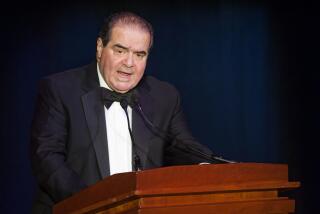It Started With Quinlan: The Ever Expanding ‘Right to Die’
- Share via
ANN ARBOR, MICH. — Few rallying cries sound more straightforward than the “right to die”--but few are more fuzzy or more misunderstood. This becomes all-too evident when comparing the right-to-die decision handed down by the U.S. 9th Circuit Court of Appeals earlier this month and the New Jersey’s Supreme Court’s decision in the Karen Ann Quinlan case 20 years ago. At different times, the “right to die” has embraced significantly different rights.
On March 6, in Compassion in Dying vs. Washington state, the 9th Circuit held that because a Washington state statute prohibiting assisted suicide prevents physicians from providing assistance to competent, terminally ill patients who want to end their lives, the law violates the due process clause of the 14th Amendment. As the author of the majority opinion, Judge Stephen Reinhardt, put it, the Constitution “encompasses a due process interest in controlling the time and manner of one’s death--there is, in short, a constitutionally recognized ‘right to die.’ ”
Supporters of assisted suicide and some civil-liberties groups view this decision as an important breakthrough that will allow more terminally ill patients to end their lives with dignity. But religious leaders and medical groups have voiced alarm that an expansive “right to die” poses great dangers for individuals who are ill and vulnerable--particularly those who are elderly or socially disadvantaged.
Reinhardt acknowledged that, in a future case, it might be difficult to make a principled distinction between physician-assisted suicide (where the patient performs the act that brings about death) and physician-administered voluntary euthanasia (where the physician performs the death-causing act), but this did not seem to trouble him as long as, in both instances, the patient desires to end her life: “We consider it less important who administers the medication [that causes death] than who determines whether the terminally ill person’s life shall end.”
This month, indeed this very day, marks the 20th anniversary of the New Jersey Supreme Court’s much-publicized decision in the Karen Ann Quinlan case. Quinlan, too, is considered a groundbreaking case, but, in some respects it was a far narrower decision than the 9th Circuit’s. Indeed, most of the judges who supported the opinion in the Quinlan case 20 years ago would probably have been taken aback by the 9th Circuit ruling.
The New Jersey Supreme Court held that Quinlan, a young woman in a persistent vegetative state, had a right to decide to be taken off the respirator that was maintaining her and that this right could be asserted on her behalf by her guardian and family. The court that decided the Quinlan case, and all the parties involved, operated on the premise that Quinlan would die shortly after the respirator was turned off. But this did not happen. She actually remained alive another 10 years. For two reasons: first, because the nun in charge refused to disconnect the respirator until Quinlan had been carefully weaned from it, and because one life-support device was never removed--Quinlan’s feeding tube.
Perhaps because they viewed feeding as “natural” or “basic” care, Quinlan’s parents did not request permission to remove the naso-gastric tube that was to keep their daughter alive for another decade. Indeed, Karen’s father voiced surprise when asked whether he wanted the feeding tube removed. “Oh, no,” he said, “that is her nourishment.”
If the Quinlans had sought permission to remove their daughter’s feeding tube, they probably would have been rebuffed--even if they could have provided convincing evidence that this was their daughter’s wish. For at the time, and as recently as the early 1980s, the idea that fluids and nutriment might be withdrawn from a comatose patient would have been repudiated, if not condemned, by most health professionals.
If removing a feeding tube from a patient would have been strongly resisted at the time of the Quinlan case, disconnecting a respirator produced far different reactions. To more than a few, the feeding tube symbolizes the essence of care and compassion. But to many people, removing a patient from an MA-1 respirator--a cold, gray, computer-programmed machine that clicks into service when the patient does not breathe voluntarily--symbolizes humankind fighting against imperious modern technology.
In the decade following the Quinlan decision, views of health professionals, courts and the public changed. By the late 1980s, the once formidable psychological and symbolic distinction between respirators and feeding tubes had virtually collapsed. In the 1990 Nancy Cruzan case (the only U.S. Supreme Court case involving death, dying and the “right to privacy”), Chief Justice William H. Rehnquist, who wrote the majority opinion, attached no significance to the fact that the life-saving measure involved was artificial feeding. Concurring Justice Sandra Day O’Connor explicitly rejected any distinction between the feeding tube and other forms of life support.
Neither the Quinlan case nor the Cruzan case establishes the kind of “right to die” that the 9th Circuit found in the Constitution--a right to determine the time and manner of one’s death and a right to the active intervention of another to bring about one’s death. The only right or liberty that the Quinlan ruling established and the Cruzan decision recognized is the right under certain circumstances to refuse life-sustaining medical treatment or, as many have called it, the right to die a natural death.
Indeed, the Quinlan case explicitly distinguished between letting her die, on the one hand (what it called “the ending of artificial life support systems”), and both direct killing and assisted suicide, on the other. No less prominent an advocate of assisted suicide and active voluntary euthanasia than the Hemlock Society’s Derek Humphrey contends that the Quinlan case is “significant,” among other things, for “distinguishing between suicide and the passive withdrawal of life supports.”
But even the judge who writes the majority opinion in a case cannot limit the impact of his words. In the last half-dozen years, lawyers throughout the land have been using the now firmly established right to reject life-saving medical treatment as a launching pad--as an argument for expanding the “right to die” to include assisted suicide and, some time in the near future, active voluntary euthanasia. With the 9th Circuit’s decision, they achieved a smashing victory.
Unlike the court in the Quinlan case, the federal court earlier this month could “see no ethical or constitutionally cognizable difference between a doctor’s pulling the plug on a respirator and his prescribing drugs which will permit a terminally ill patient to end his own life.” According to the 9th Circuit, “what matters most is that the death of the patient is the intended result as surely in one case as in the other.”
The U.S. Supreme Court is still to be heard from. Whether the higher court will agree with the 9th Circuit or whether it will find a constitutional distinction between terminating a patient’s life support and actively intervening to promote or to bring about death remains to be seen. But however the Supreme Court ultimately resolves this issue, one point remains clear: There is a good deal of distance between the “right to die” promulgated by the New Jersey court in Quinlan 20 years ago and the “right to die” adopted by the 9th Circuit this month in Compassion in Dying.
More to Read
Sign up for Essential California
The most important California stories and recommendations in your inbox every morning.
You may occasionally receive promotional content from the Los Angeles Times.










